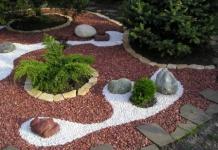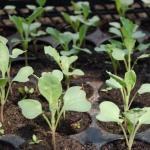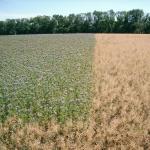Cauliflower is not only very tasty, but also a healthy garden crop, so many farmers grow it in their summer cottages. By cultivating a vegetable in seedlings, you can harvest an early harvest. At the same time, growing cauliflower at home does not cause any particular difficulties, however, in order for it to be of high quality, certain recommendations must be followed. Read about them later in this article.
general information
Cauliflower is one of the most valuable types of vegetables. It contains a huge amount of vitamins, minerals and macronutrients that our body needs for normal life. In addition, this culture has healing properties that were discovered by people more than seven thousand years ago. For the first time, cauliflower began to be cultivated in Eastern Europe, presumably in France, and later, through the Celts and Gauls living on the territory of modern Germany, garden culture came to Rus'. Due to the large number of healing properties and incredible taste, the vegetable quickly gained popularity, it began to be grown almost throughout the entire territory of our country.
Cauliflower, the cultivation of which is very laborious, can be consumed even by people with a pronounced allergy to various foods. It will be an excellent source for them of vitamins such as B, C, E, as well as K and U, which are very rare for vegetables, and nutrients.
Cabbage contains a large amount of the following elements:
- cellulose;
- biotin;
- tocopherol;
- rutoside;
- niacin;
- calcium;
- zinc;
- magnesium;
- phosphorus;
- potassium;
- iron;
- pectin;
- sulfur;
- chlorine;
- amino acids;
- malic and citric acid;
- and many others.
Thanks to fiber, cauliflower helps cleanse the blood and the whole body from toxins and other harmful substances, and it also reduces the harmful effects of radioactive radiation on humans. According to scientists, regular consumption of cauliflower significantly reduces the risk of developing cancer of various etiologies. In addition, cauliflower (growing and care will be discussed later) normalizes metabolic processes in the body, improves hematopoietic function and contributes to the normal formation of bone tissue.
Basic cultivation methods

This process must be taken very seriously. Growing cauliflower seedlings can be done in two ways - classic and in pots. The first method involves planting seeds in boxes or a greenhouse, and for the second, you will need to make a special peat substrate. The root system of the culture does not develop very well and is too demanding on many environmental factors, however, with proper cultivation, it takes root very quickly in the garden and starts to grow. Some vegetable growers use mixed technology. They first plant the seeds in a greenhouse, and when they germinate, they transplant them into peat pots.
Timing
It takes 45 days for the planting material to be ready for transplanting into open ground. Sowing seeds is most often carried out in early or mid-spring. This is the optimal time, which is enough for the seedlings to get stronger, and you could get an early harvest. However, it is important to take into account the climatic features of the region in which you live. For example, in the south of Russia, it is possible to transplant seedlings from pots to a garden bed much earlier than, for example, in the central or northern regions.
When choosing the time for sowing seeds, keep in mind that it takes 45 days for them to germinate and form a strong root system. In this way, you will be able to calculate the exact planting date for your region. As mentioned earlier, the cultivation of cauliflower in the open field can be done in seedlings. The best option would be a greenhouse, because it is the least hassle. As for specific varieties, it is best to give preference to early hybrids. They grow faster than others, so you can harvest in the middle of summer.
Soil preparation

So what does this process involve? at home and which must be cared for in compliance with a certain technology, will not be able to take root and grow normally on depleted soils that do not contain enough minerals and macronutrients. Therefore, deciding to start cultivating a vegetable, take care of the soil first. It is better to fill the greenhouse with a mixture consisting of equal parts of soddy soil, peat and humus. It is also recommended to fertilize the substrate in advance with universal preparations, which contain phosphorus.
In addition, it is desirable to carry out disinfection of the soil. To do this, use a not too strong solution of potassium permanganate. And to protect seedlings from various diseases, calcined sand is used, which is sprinkled on the ground after planting.
Planting material preparation
So, you want to grow cauliflower in your garden. Growing this vegetable does not require much effort if the planting material is properly prepared. Before sowing seeds, they must be sorted out, warmed up and treated with pesticides. This will significantly speed up the germination process and prevent the development of various diseases. At the same time, try to select only large seeds, since small ones sprout very rarely, and also give a low yield.
Warming involves placing seeds wrapped in gauze for 20 minutes in water heated to 50 degrees Celsius. Next, the planting material is well dried and pickled for an hour with garlic juice or a weak solution of formaldehyde.
Landing

The earth in the boxes must be well leveled, after which seeds are sown on it and sprinkled with soil on top, the layer should be 0.5-0.7 cm thick. According to many vegetable growers, they germinate very quickly. When the planting material is planted, the substrate is sprinkled on top with a layer of calcined sand or wood ash, after which it is thoroughly sprayed with a spray bottle.
Cauliflower, the growing conditions of which can be very different, does not need special care. From time to time, you only need to moisten the soil and remove weeds. The same applies to planting seeds in a greenhouse. When growing in boxes, it is necessary to maintain the air temperature in the room at +19 ° C, while avoiding drafts.
Planting seedlings in open ground
When the seeds sprout and the seedlings are strong enough (on average, this takes 45 days, as mentioned at the beginning of the article), the seedlings can be transplanted into the garden. However, shortly before this, approximately 2-3 weeks in advance, it is recommended to reduce the temperature in the room or greenhouse to approximately +15 °C. This is necessary so that the vegetable is a little stronger and adapts faster in the open field. By adhering to these recommendations, you can get high-quality, healthy and strong planting material, which in the future will give a rich harvest.

The optimal time for diving occurs approximately 7-10 days after seed germination. In order for cauliflower (growing a crop is distinguished by its simplicity compared to other types of vegetables) to grow well and quickly, it is necessary to properly plant it in open ground. At the same time, it is very important not to overexpose the seedlings in boxes, since in this case the root system may suffer.
Experts recommend diving and planting young cabbage in special peat pots. This will strengthen the root system and accelerate the growth of cauliflower. In this case, the sprouts should be buried in the substrate to the cotyledon leaves, and the soil should be sprinkled on top with a layer of mulch, for example, wood ash can be used. It is worth noting that you can make peat pots yourself, but experienced vegetable growers recommend buying ready-made ones in specialized stores. They have a very affordable price.
Making peat pots with your own hands
Features of growing cauliflower differ from those for other types of vegetables. The culture will give a much better quality crop if the seedlings are transplanted first into peat pots, and only then into open ground. If you do not want to buy them, then you can do everything yourself.
This will require the following materials:
- lowland peat with an acidity level of not more than 6.5;
- sawdust, to which a small amount of ammonium nitrate solution is added (this will kill all bacteria and harmful organisms that can absorb nitrogen from the atmosphere);
- sand;
- fresh mullein, which is diluted with water in equal proportions.
To prepare the substrate, take one part of peat and sawdust, as well as 0.2 sand. As for fertilizer, a small amount is needed. It is very important not to overdo it, because otherwise the soil will turn out to be too dense and the root system will not be able to develop normally. Also, cauliflower, which is grown practically without the use of chemicals, adapts much faster in a new place if it is fed with any universal mineral fertilizer.
Growing seedlings in peat tablets
This technology was invented relatively recently, however, it has already been able to prove its effectiveness. Peat tablets can be purchased at almost any grocery store. They are laid out in ordinary disposable cups and poured with warm water. After the tablets increase in size and acquire a loose consistency, seeds are planted in them. This method allows you to get very strong, strong and healthy seedlings.
Cultivation without picking

So, is it possible? Growing cauliflower from seeds can also be done without diving. This method is simpler, and the seedlings are of fairly high quality. The essence of the cultivation method is that the seeds are immediately planted in peat pots. But here it is better to use later varieties of cabbage.
The advantage of no-dive cultivation is that the planting material can be immediately planted directly on the bed. In this case, the sowing density of seeds should be sufficiently high. To protect the cauliflower from the cold, metal arcs are installed along the edges of the hole, on which the film is stretched.
A few words about fertilizer

Cultivation of cauliflower in open ground can be carried out without the use of dressings. But in order for the yield, as well as the taste and useful qualities to be high, it is recommended to fertilize the vegetable several times in a timely manner. To do this, you can use a solution of ammonium nitrate or any other mineral fertilizers. Plants are watered with a nutrient solution under the root twice with an interval of 10 days after diving.
Seedling hardening
What is it for? If you live in a region with a cold climate, then in order for the cauliflower to survive the frost, it must be hardened. The preparation consists in the fact that approximately two weeks before the expected dive, boxes with planting material are taken out into the street for several hours. And five days before planting, the seedlings should be placed in a greenhouse, in which it will stay immediately before planting in open ground.

If you stick to the technology described in this article, you will get an excellent cauliflower crop. Growing and caring for it in the open field will not take much time. The vegetable will delight you with a rich and high-quality harvest. Experienced vegetable growers advise not to make holes too deep when diving, and plants should not be planted very tightly relative to each other. Culture loves space, so there should be at least 25 centimeters between plants. It is necessary to water the cabbage abundantly, but not too often, in order to prevent the root system from rotting.
This, in fact, ends our article on how to grow cauliflower with your own hands. This is an amazing vegetable with great nutritional value, so you simply must plant it in your garden.
Broccoli in the photo
A high-vitamin crop ripens in early June - two weeks earlier than cauliflower. Broccoli is undemanding to heat, at temperatures above 25 ° C and below 10, dry air and soil, the yield and product quality are sharply reduced. For growing broccoli seedlings, the optimum temperature for growth and development should be 16-25 ° C. The culture withstands frosts and minus 7 ° C.
To get an early harvest, broccoli is grown from seedlings, just like cauliflower. When planting broccoli seeds in boxes March 8-12. Seedlings are planted in the ground in late April - early May in a well-watered garden bed. Watered so that the top layer of soil 30 cm deep was moistened. The distance between rows when sowing broccoli seedlings should be 45-50 cm, and between plants - 30 cm.
In order to receive products until late autumn, seeds for seedlings are sown at several times at intervals of 15 days, the last sowing date is June 20. Seeds can be sown directly on the bed with subsequent thinning.
Broccoli grows on soils well seasoned with organic and mineral fertilizers. To grow strong broccoli seedlings, 1 bucket of compost soil, 3 tablespoons of garden mixture, and a half-liter jar of ash are added to 1 m2 of beds.
Sowing cauliflower seeds for seedlings (with video)
If you want to get an early harvest of cauliflower, grow it early (March, April) with seedlings.
During these periods, cauliflower is planted in the greenhouse for seedlings of varieties:
 Cauliflower seeds “Guarantee”
Cauliflower seeds “Guarantee”  Cauliflower “Guarantee”
Cauliflower “Guarantee”
Guarantee,
 Cauliflower seeds “Movir 74”
Cauliflower seeds “Movir 74”  Cauliflower “Movir 74”
Cauliflower “Movir 74”
Movir 74,
 Cauliflower seeds “Snowball”
Cauliflower seeds “Snowball”  Cauliflower “Snowball”
Cauliflower “Snowball”
Snowball,
 Cauliflower seeds “Early Gribovskaya 1355”
Cauliflower seeds “Early Gribovskaya 1355”  Cauliflower “Early Gribovskaya 1355”
Cauliflower “Early Gribovskaya 1355”
Early Gribovskaya 1355.
The soil for growing seedlings of cauliflower should be lighter than for seedlings of other types of cabbage. Cauliflower seedlings grown in a greenhouse are transplanted into open ground, depending on the weather conditions in April, and under a film cover - 10-15 days earlier.
Before you grow cauliflower seedlings, you need to prepare the soil: this is done in the same way as for cabbage varieties. Cauliflower is usually grown in the first year after manure application, while the doses of mineral fertilizers and the timing of their application are the same as for cabbage. It should be taken into account that an excess of nitrogen leads to a decrease in the density of the heads.
When sowing cauliflower for seedlings, it must be remembered that it is sensitive even to a short-term deficiency of water and nutrients. During the cultivation of cauliflower seedlings in the greenhouse, top dressing is done (two weeks after germination) using the Agricola-1 fertilizer solution. Seedlings are planted in a permanent place after at least 4 true leaves have formed.
A good harvest is possible when sowing seeds for seedlings on a bed under a film in the third decade of April.
Seeds are sown at a distance between rows of 10 cm, in a row - 5-6 cm. After sowing, the bed is covered with covering material or low arcs are placed and a plastic film is pulled over them. On warm days, the film is slightly opened or completely removed, otherwise the seedlings will quickly stretch. It should not overgrow, as in this case, "button" rosettes may form.
To obtain a cauliflower crop at a later date (which is planned for harvesting at the end of September - October), the seeds are sown in May (the first - third decade) in the same way. Seedling care is the same as for earlier sowing dates. First, seedlings are grown in a small area of the beds, and then, in June, they are transplanted to a permanent place.
Seedlings are planted on ridges up to 100 cm wide. After digging, 1 cup of wood ash is added per 1 m2, 1 tbsp. a spoonful of superphosphate and nitrophoska and 2-3 kg of organic fertilizers (manure or vegetable humus). After that, the bed is dug up to a depth of 10-12 cm. Seedlings are planted according to the scheme: 50 cm between rows, in a row - 25-30 cm.
The video "Sowing cauliflower for seedlings" shows all the basic agricultural practices:
Cauliflower grows well on loose loam or sandy loam with a high humus content. But in any case, you can not plant plants in freshly dug up soil, you should wait at least a week. Loose earth should be somewhat compacted. Cauliflower (like cabbage) loves compacted, prepared soil a few months before planting.

Growing cauliflower in a greenhouse in the photo
The acidity of the soil in the greenhouse should be neutral or slightly acidic. Lime is applied in the autumn of the year preceding planting. If field horsetail, oxalis, sorrel grow on the site, this is an indicator of acidic soil. Doses of lime, depending on the acidity and severity of the soil, range from 0.3 to 0.5 kg/m2. When preparing the soil, the most effective way to reduce acidity in a greenhouse is to first sprinkle the soil evenly with lime or ash, and then sprinkle with manure (mullein), and then dig. Cauliflower loves high doses of humus or compost. It should be borne in mind that the soil and the fertilizer used affect its taste. Cauliflower responds positively to top dressing with boron and molybdenum in the seedling phase.
Fertilizer for cauliflower is applied as well as for white cabbage. However, the best, warmer places are reserved for cauliflower. In the spring, 6-8 kg of manure or compost, 20-25 g of double superphosphate, 30-35 g of potassium chloride or sulfate, 0.5 teaspoon of boric acid, ammonium nitrate 25-30 g or urea 15 g / m2. To save fertilizer, some of them are brought into the planting holes, thoroughly mixing with the soil. It is useful to add wood ash to potash fertilizers, especially in planting holes.
Before growing seedlings of Brussels sprouts, the soil should be prepared in the previous autumn, with the addition of a layer of manure and compost in the amount of one and a half buckets per 1 m2. Leave the soil open to snow and wind, and then loosen it in the spring at a depth of 2.5 or 5 cm, adding fish droppings at a rate of 120 g per m2. Instead, you can use a mixture of one part potash sulfate, four parts bonemeal at a rate of 120 g per m2.

Growing Brussels sprouts in the photo
Planting Brussels sprouts for seedlings is done in a box or in a pot in March or April, in holes no deeper than 12 mm at a distance of about 15 cm from each other. They should be covered with plastic bags to keep them warm and protected. When they start to germinate, they need to be thinned out to give them space to develop.
Immediately after planting potted seedlings, loosening is done, when planting potless seedlings - no later than 3-5 days later.
Planting should begin when the seedlings reach 10-15 cm in height. You need to plant in a position in which they will be ready to ripen, you should continue to sit down until mid-August. It will be good if you pour plenty of water on them the day before you are going to transplant. Brussels sprouts should be planted at a distance of 90 cm from each other, so that their lower leaves are above the soil level. After the plants are transplanted, they need to be well watered. As they grow, you may need to secure them to poles in strong winds.
One of the most important measures for growing seedlings of Brussels sprouts, like all other types of plants of the Cabbage family, is picking. Its purpose is to maintain the soil in a loose state in order to create a favorable water and air regime for the growth and development of plants.
Brussels sprouts should be planted in the ground in late May or early June.
The most familiar in our area is white cabbage. In autumn, it is consumed raw, pickled and stewed. But mothers often notice that this product causes bloating in babies. For this reason, not white cabbage, but cauliflower is recommended for complementary foods. It is advisable for nursing mothers to consume this vegetable in small quantities. And at what age can children be given Brussels sprouts and broccoli?
Cauliflower
Even the medieval healer Avicenna in his books described the benefits of cauliflower. This is a variety familiar to our region, which mothers often choose as the first complementary foods for a six-month-old child.
Peculiarities
- It is easier to digest than other types of cabbage and does not irritate the mucous membranes of the stomach.
- Retains most of the vitamins during heat treatment.
- Contains large amounts of potassium and calcium.
As in any other cabbage, useful fiber is present in cauliflower. But its peculiarity is that it is easier to digest, which is why the product is suitable for the first complementary foods.
Broccoli
This is a hypoallergenic vegetable, it is recommended as the first complementary foods (from 6 months) for babies. Broccoli is the closest relative of cauliflower. The variety was bred many centuries ago, but was known only in Italy. Cabbage is quite unpretentious and grows in many countries. The only wish when choosing is to find a vegetable that has not been treated with chemicals from pests. Broccoli also grows in our region, so you can order it from friends involved in agriculture.

Peculiarities
- Surpasses other varieties of cabbage in the content of vitamin A.
- Contains a lot of protein.
- The composition contains folic acid, so cabbage is recommended for pregnant women.
- The content of vitamin C is high, but it is reduced by half after several days of storage.
In order for cabbage to retain its beneficial properties, it must not be digested. The best cooking method is steam.
Brussels
Her appearance attracts kids 1-3 years old. You can give this variety to a child who has already met with colored and broccoli. Green small cabbages will become even brighter if they are steamed. There are many recipes for casseroles and other delicious dishes with this variety of cabbage.
Be careful when choosing a vegetable for a child: yellowed leaves indicate that the cabbage has been plucked for a long time, which means that it has lost some of its useful properties. This variety perfectly tolerates low temperatures, so you can safely use frozen vegetables.

Peculiarities
- This cabbage is a valuable source of B vitamins.
- High content of trace elements: iodine, copper, fluorine, zinc.
- Easily digestible iron prevents the development of anemia in pregnant women and children.
Raw cabbage is sometimes bitter, so do not rush to give it to your baby. For yourself - cut as small as possible and sprinkle with lemon juice. This will take away the bitterness.
Scientists have long established that vegetables grown where a person lives are much more beneficial for him than those brought from afar. This is partly why I started gardening seriously. For about 20 years I have been going to the club of amateur gardeners. I try to use all the knowledge gained in practice. I test and evaluate new varieties, carefully measure and weigh the crop, write everything down in a journal and ...
I draw conclusions.
On my 6 acres I grow early cabbage: white, cauliflower, broccoli, kohlrabi. Under the cabbages, only one bed is occupied, 1 m wide and about 6 long. I plant 6-8 plants of each type. This is quite enough for our family for the summer, as the harvest is always stable and high.
I choose Dutch.
In order to get the maximum amount of vegetables with minimal effort, you must first of all use modern varieties, or better, hybrids, because they are more productive and less vulnerable to diseases and pests.
Lately, I have been preferring Dutch-selected cabbage, adapted to our geographical area. And my harvests are more and more convincing that the right choice was made.
Early white cabbage Parel, Hermes reaches 2-2.5 kg for me. Vinson and Goodman cauliflower heads come in 1.5 to 2.5 kg. In the Fiesta broccoli hybrid, the central head grows to 1.5 kg or more. Moreover, numerous lateral small inflorescences can be cut off until autumn. And the largest kohlrabi cultivar of the Giant variety in September last season pulled as much as 4.5 kg.
Dutch seeds are treated with fungicides and covered with a bright film. Therefore, they are sown dry. I sow early cabbage for seedlings on March 20-25, each type is in a separate box. As a substrate, I use soaked pressed peat briquettes "Violet", adding washed river sand and dolomite flour. So that the seedlings do not stretch out, a special temperature regime is needed. Before germination, I maintain about 20 ° C. After their appearance and before picking, I put the boxes in the refrigerator for the night, and during the day I put them on a lighted window closer to the glass.
I dive the plant in the stage of the first true leaf into separate small glasses. I deepen to cotyledon leaves. I water regularly, avoiding either overdrying or waterlogging. In addition, I feed pets with complex mineral fertilizer with trace elements.
Before transplanting into the ground, I always harden young plants, taking them out into the street and gradually increasing their time in the open air. Seedlings before planting should be stocky, with 4-6 large leaves on thick petioles. In such plants, the root system is strong, high-quality, strong, high-quality.
It is very important to choose the optimal place for the garden. All cabbages are photophilous, therefore, if you plant them in partial shade, you can not count on a good harvest of heads and heads.
Vegetable beds on my site are permanent. Each is limited on all sides by boards or curb tape. The soil is loose, so I work with a pitchfork, not a shovel. Since autumn, I have been choosing another bed for cabbages, remembering about unwanted predecessors - turnips, radishes, radishes. Digging, be sure to bring in dolomite flour or ash to reduce the acidity of the soil, because cabbage does not tolerate acidic soils.
To get a faster harvest, I plant potted seedlings in a permanent place as early as possible - in late April - early May. I pre-align the beds and make 2 rows of wide holes along the surface in a checkerboard pattern. The distance between rows is 55-60 cm, and between the holes in a row is 40-45.
All cabbages, and especially cauliflower, are demanding on soil fertility. Even if the land is well-groomed, but not fertilized enough, plants may lag behind in growth. Therefore, in each hole I add a quarter of a bucket of mature compost, half a glass of ash and an incomplete tablespoon of nitrophoska, universal Kemira or other complete fertilizer.
Deceptive methods of protection.
The most malicious disease in cabbages is keel, which is easily brought to a site with someone else's seedlings. And with a keel you won’t get around the hassle ... I was convinced from my own experience that in order to prevent the disease, it would be good to put a piece (1-2 cm) of a rhubarb stalk, an eggshell with ash under each plant when planting. By the way, a decrease in soil acidity, as well as compliance with crop rotation, prevent the appearance of keel.
When planting kohlrabi, I cover the stem with soil up to the root collar so as not to interfere with the growth of the stem. I deepen the rest of the seedlings to the first true leaf. I make an annular groove around each plant for watering and fertilizing. I water the cabbage abundantly with phyto-sporin or humate, and also spray it with epin-extra growth regulator or zircon and cover each plant with a transparent plastic 5-liter bottle with a cut bottom. All these measures are necessary for the fastest rooting. As a rule, my seedlings take root completely.
Cabbage loves moisture. A good harvest is obtained with regular watering and loosening. I usually water in the evening. Plentifully, but not often - depending on the weather. I never allow the soil to dry out. Cauliflower does not tolerate drought more than other cabbages. It is known that for the formation of a good head, it should have 16-20 leaves. At the height of summer, if there is not enough moisture, the growth of leaves stops. And sad: the result is formed small non-commodity heads.
Another misfortune is weeds. It is necessary to keep the beds clean, as young pets on land overgrown with weeds are significantly stunted. Therefore, I regularly loosen the soil, removing weeds. Several times during the season I spud all cabbages, except for kohlrabi. Hilling prevents the stem from bending and helps to form additional roots, which enhance the nutrition of the bush.
Every 2 weeks I feed cabbages. The first top dressing should be 10-15 days after planting the seedlings, as soon as it starts to grow. For better leaf development, I use organic matter: fermented grass infusion, diluted mullein or compost infusion. I add to 10 liters of finished top dressing 1 tbsp. a spoonful of urea. For all subsequent dressings, I take a solution of a complex mineral fertilizer with microelements (mortar, Kemira Lux or combi: 1.5-2 tablespoons per 10 liters of water).
Significantly increase the yield of cabbage foliar top dressing with microelements. Cabbage happens to be grateful for the additional addition of boron and molybdenum. I spray the plants with a complex of microelements cytovit. Its effectiveness is enhanced if the drug is used together with epin-extra or zircon.
There is probably no vegetable more tasty for pests than cabbage. Its main enemy is caterpillars of turnip and cabbage whites, as well as cabbage scoops. How to deal with them? The easiest way is to inspect the side leaves from below at least once a week and destroy the eggs and caterpillars.
An effective method of color deception, when white plastic yogurt jars hung on stakes, distract butterflies from cabbage. Another deceptive method is based on smells that butterflies do not like. Sprinkle the cabbage with a coniferous extract bought at a pharmacy (2 tablespoons per 10 liters of water), camphor oil or ammonia (1 tablespoon per 10 liters of water). The smell of celery also repels pests, so I plant this odorous vegetable over cabbage. Of course, there are also chemicals, but it is better not to use them.
From the end of June, I begin to selectively harvest cabbage as it ripens. It is better to do this in the evening or early in the morning. You can not overexpose the vegetable in the garden, otherwise the quality deteriorates. In white cabbage, heads of cabbage crack, in cauliflower, the head grows and crumbles, broccoli blooms, becomes loose and ceases to form side shoots, in kohlrabi, the stem becomes woody.
Despite the fact that the melon is a "purebred southerner", summer residents grow it not only in the south. And all because this culture is exceptionally tasty and very healthy. And varieties “for the market” do not always have high taste qualities, not like fruits from their own garden or greenhouse. True, the melon has its own "secrets", but they are not particularly difficult. Therefore, if you have not yet grown a melon on your hundred square meters, you must definitely try it, at least once!
Salad "Red Sea" with squid, crab sticks and red caviar is a light and healthy snack that is suitable for a pescatarian menu, it can also be prepared on fasting days when fish and seafood are allowed on the menu. The salad is simply extremely tasty and it is prepared easily. Buy frozen squids. I do not advise you to cook a dish with giant squid fillet, although it looks appetizing and tempting, it has a sharp ammonia flavor that is difficult to get rid of.
Columnar trees differ from ordinary fruit trees in their compact crown, small height, and lack of lateral branching. With a slight habitus, these miracle trees are distinguished by their ability to form large crops of large, tasty and beautiful fruits. On 1-2 acres, you can place up to 20-25 columnar trees - varieties of apple trees, pears, plums, peaches, cherries, apricots and other crops of different maturity. Our article will tell about the features of creating a columnar garden.
August can be a little sad - autumn, followed by a long winter, is already on the threshold. But the flower beds are still full of multicolor, and their colors create an atmosphere of warmth and joy. The rich palette of August flower beds mainly consists of yellows, oranges, and crimson tones. And it seems as if the garden has become warmer and the color of the sun has increased. What flowers should definitely be planted in flower beds so that they brighten up the inevitable departure of summer with flowering?
Peach jam with bananas is fragrant, thick, healthy and, most importantly, it has half as much sugar as ordinary jam. This is a quick jam with pectin, and pectin powder is known to reduce the sugar content in jam, or even make it without sugar. Sugar-free jams are fashionable sweets in our time, they are very popular among supporters of a healthy lifestyle. Peaches for harvesting can be of any degree of maturity, bananas too.
Coriander is one of the most popular spices in the world, and its greens are called cilantro or cilantro. Interestingly, cilantro leaves no one indifferent. Some people adore it and are happy to use it in any salads and sandwiches, and they love Borodino bread for the special flavor of coriander seeds. Others, referring to the smell that evokes associations with forest bugs, hate coriander and flatly refuse to approach bunches of cilantro even in the market, let alone plant it in their garden.
Saintpaulias are making a comeback and redefining the cute blooming violets that love to live on any windowsill. Trends in the "market" for uzambara violets indicate a rapid increase in interest in plants with unusual leaves. More and more admiring glances are attracted not by unusual colors of flowers, but by exotic variegated colors of leaves. Variegated saintpaulias are almost no different in cultivation from all the others.
Sweet and sour pickled cherry tomatoes with red onion and basil marinated with balsamic vinegar and mustard. Such pickled vegetables will decorate any festive table, they are very tasty and fragrant. Marinade filling is a completely different story: it turns out a delicious brine, the only drawback of which is a small amount. Onions choose sweet, red. Cherry - strong, slightly unripe, the smallest. Fresh basil is suitable for both green and purple.
My first acquaintance with hydrogel took place a very long time ago. Back in the nineties, my husband brought funny multi-colored balls from Japan, which greatly increased in size if they were filled with water. They were supposed to put bouquets or use them for some other decorative purposes. Of course, at first it was funny, but then I played enough and abandoned them, I don’t even remember where they went. But I recently returned to the use of hydrogel. I will share my experience in this article.
Watermelon and summer are inseparable concepts. However, not in every area you will find melons. And all because this African plant takes up a lot of space, is quite demanding on both heat and the sun, and also on competent watering. But still, watermelon is so loved that today not only southerners, but much more northern summer residents have learned to grow it. It turns out that you can find an approach to such a capricious plant, and if you want, you can get a decent harvest.
You can cook red gooseberry jam in 10 minutes. However, it should be borne in mind that this is the time required for cooking jam without preparing berries. It takes a lot of time to harvest and prepare berries for processing. Cruel thorns discourage any desire to harvest, but you still have to cut off your noses and tails. But the result is worth it, the jam turns out to be excellent, one of the most fragrant, in my opinion, and the taste is such that it is impossible to tear yourself away from the jar.
Monsters, anthuriums, caladiums, dieffenbachia ... Representatives of the Aroid family are considered one of the most popular categories of indoor plants. And not the last factor of their wide distribution is diversity. Aroids are represented by aquatic plants, epiphytes, semi-epiphytes, tuberous and vines. But despite such a diversity, because of which it is sometimes difficult to guess the relationship of plants, aroids are very similar to each other and require the same care.
Salad "Donskoy" for the winter - a savory appetizer of fresh vegetables in a sweet and sour marinade with olive oil and balsamic vinegar. In the original recipe, the vinegar is plain or apple, but with a combination of wine vinegar and light Balsamico, it turns out much tastier. Salad can be prepared without sterilization - bring the vegetables to a boil, put them in sterile jars and wrap them warmly. You can also pasteurize blanks at a temperature of 85 degrees, then cool quickly.
The main collected mushrooms: porcini, boletus, boletus, chanterelles, boletus, mossiness mushrooms, russula, milk mushrooms, volnushki, saffron mushrooms, honey mushrooms. Other mushrooms are collected depending on the region. And their name (other mushrooms) is legion. As well as mushroom pickers, which are becoming more and more every year. Therefore, there may not be enough for all known mushrooms. And I know for sure that among the little-known come across very worthy representatives. I will tell you about little-known, but tasty and healthy mushrooms in this article.
The word "ampel" comes from the German word "ampel", meaning a hanging container for flowers. Fashion for hanging flower beds came to us from Europe. And today it is very difficult to imagine a garden where at least one hanging basket was not found. In response to the growing popularity of container floriculture, a large number of ampelous plants have appeared on sale, whose shoots easily fall outside the pots. Let's talk about those that are valued for their beautiful flowers.


















